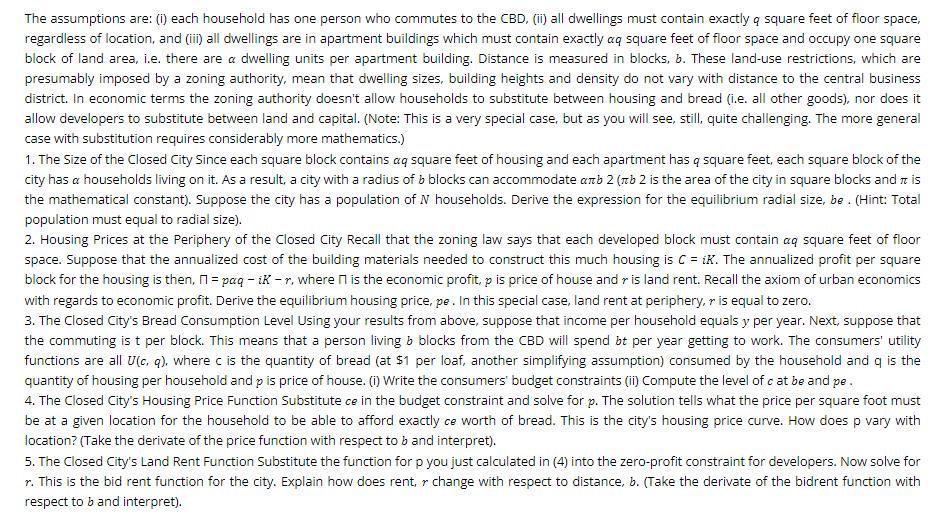Answered step by step
Verified Expert Solution
Question
1 Approved Answer
The assumptions are: (i) each household has one person who commutes to the CBD, (ii) all dwellings must contain exactly q square feet of

The assumptions are: (i) each household has one person who commutes to the CBD, (ii) all dwellings must contain exactly q square feet of floor space, regardless of location, and (iii) all dwellings are in apartment buildings which must contain exactly aq square feet of floor space and occupy one square block of land area, i.e. there are a dwelling units per apartment building. Distance is measured in blocks, b. These land-use restrictions, which are presumably imposed by a zoning authority, mean that dwelling sizes, building heights and density do not vary with distance to the central business district. In economic terms the zoning authority doesn't allow households to substitute between housing and bread (i.e. all other goods), nor does it allow developers to substitute between land and capital. (Note: This is a very special case, but as you will see, still, quite challenging. The more general case with substitution requires considerably more mathematics.) 1. The Size of the Closed City Since each square block contains aq square feet of housing and each apartment has q square feet, each square block of the city has a households living on it. As a result, a city with a radius of b blocks can accommodate ab 2 (b 2 is the area of the city in square blocks and is the mathematical constant). Suppose the city has a population of N households. Derive the expression for the equilibrium radial size, be. (Hint: Total population must equal to radial size). 2. Housing Prices at the Periphery of the Closed City Recall that the zoning law says that each developed block must contain aq square feet of floor space. Suppose that the annualized cost of the building materials needed to construct this much housing is C = (K. The annualized profit per square block for the housing is then, = paq - iK-r, where is the economic profit, p is price of house and r is land rent. Recall the axiom of urban economics with regards to economic profit. Derive the equilibrium housing price, pe. In this special case, land rent at periphery, r is equal to zero. 3. The Closed City's Bread Consumption Level Using your results from above, suppose that income per household equals y per year. Next, suppose that the commuting is t per block. This means that a person living b blocks from the CBD will spend bt per year getting to work. The consumers' utility functions are all U(c, q), where c is the quantity of bread (at $1 per loaf, another simplifying assumption) consumed by the household and q is the quantity of housing per household and p is price of house. (i) Write the consumers' budget constraints (ii) Compute the level of c at be and pe. 4. The Closed City's Housing Price Function Substitute ce in the budget constraint and solve for p. The solution tells what the price per square foot must be at a given location for the household to be able to afford exactly ce worth of bread. This is the city's housing price curve. How does p vary with location? (Take the derivate of the price function with respect to b and interpret). 5. The Closed City's Land Rent Function Substitute the function for p you just calculated in (4) into the zero-profit constraint for developers. Now solve for r. This is the bid rent function for the city. Explain how does rent, change with respect to distance, b. (Take the derivate of the bidrent function with respect to b and interpret).
Step by Step Solution
★★★★★
3.46 Rating (156 Votes )
There are 3 Steps involved in it
Step: 1
s 1 be N 2 pe Kq i 3 Compute the bread consumption level at the equilibrium radial size and housing ...
Get Instant Access to Expert-Tailored Solutions
See step-by-step solutions with expert insights and AI powered tools for academic success
Step: 2

Step: 3

Ace Your Homework with AI
Get the answers you need in no time with our AI-driven, step-by-step assistance
Get Started


